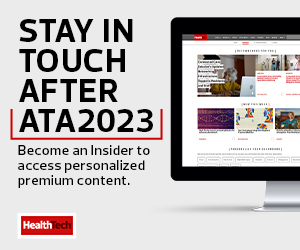2. We Must Roll Back Erosion of Trust in Healthcare
Trust was a recurring theme throughout the conference. ATA Chair-Elect Dr. Sreekanth Chaguturu, executive vice president and chief medical officer of CVS Health, spoke passionately about the significant drop in trust in institutions, including healthcare institutions, over the past several years.
Rebuilding that trust means that we have to understand the journey and meet patients and consumers wherever they are on that journey. Virtual care modalities are a perfect toolset for meeting people where they are. Digital transformation tools, while promising, must be developed and implemented with a rigorous methodology to ensure that bias is removed and the impact is personalized to individual patients.
To restore trust in our institutions, we as an industry — patients, providers, payers, technology, government and employers — must collaborate and design a shared vision as we progress toward the #FutureOfCare.
MORE FROM ATA: Learn how strong leadership and integrated tools support hybrid care.
3. Stability Breeds Creativity for Telehealth
Now that the industry has been given some breathing room in the form of last year’s omnibus bill removing the reimbursement barrier, people can start to ask, “What else can I do?”
We’re seeing an explosion of new care models that are solving some of the problems we see in the market pertaining to clinician burnout, lagging outcomes and healthcare inequity. Limited-resource programs are being cantilevered with powerful, novel technology in innovative and targeted ways to further democratize healthcare. Such creativity is only possible when we have a strong foundation to stand on, and it’s the ATA that has led the way to make that happen. #GoTelehealth
4. AI is the Next Step in the Digital Transformation of Healthcare
Whether it’s generative, diagnostic, computer vision, machine audio, robotic clinical automation or other forms of artificial intelligence, it’s clear that AI is the natural successor to synchronous and asynchronous telemedicine and remote patient monitoring. That point was emphasized best by Dr. Jay Sanders, ATA founder and past president, considered to be the father of telemedicine.
At the 30th anniversary gala, Sanders shared a powerful story of his time in residency using an algorithmic decision tree to diagnose rare disease. While testing the algorithm — ironically, to appease his professor — he was surprised to find it accurate when the pathology report came back three days later. Sanders was doing AI in 1969 with, as he said on Sunday, “only one problem: We just didn’t have the computer power then.” Well, guess what we have now.
Artificial intelligence is currently being used to solve issues related to scale, experience and engagement, clinical quality, access and so much more. It’s also quite clear that there is a lot of work to do to ensure ethical practices in AI design and implementation and to build an iterative regulatory and statutory framework around it.
We must be mindful of the lessons learned from the evaporated promise of past technology and ensure that its use removes the burden from our clinicians and patients. As Sanders put it, “We need to change from a single physician at the bedside to collective expertise.” #AdditionThroughSubtraction #MachinesMakeCareMoreHuman
EXPLORE ATA INSIGHTS: There’s more to do to make telehealth an integral part of care delivery.
5. ATA Is Where the Conversation Is
Coming to San Antonio, I knew that I’d get a chance to reconnect with longtime colleagues from whom I’ve learned so much over the years, as well as many other dynamic and brilliant leaders in this space. As co-chair of the ATA Digital Transformation Special Interest Group, I got to lead an incredible discussion among clinicians and administrators, and attendees from large and small provider organizations, digital health companies, government entities and more.
We spent an hour talking through future-of-care technologies, innovative care models, use cases and barriers to adoption. I can’t wait to run that audio recording through a transcription and natural language processing AI to pull out the nuggets of wisdom from such a powerhouse group of knowledgeable individuals. ATA special interest groups are where the magic happens. My call to action: Keep coming out to our ATA Digital Transformation SIG! The conversation is #JustGettingStarted.
This article is part of HealthTech’s MonITor blog series.












